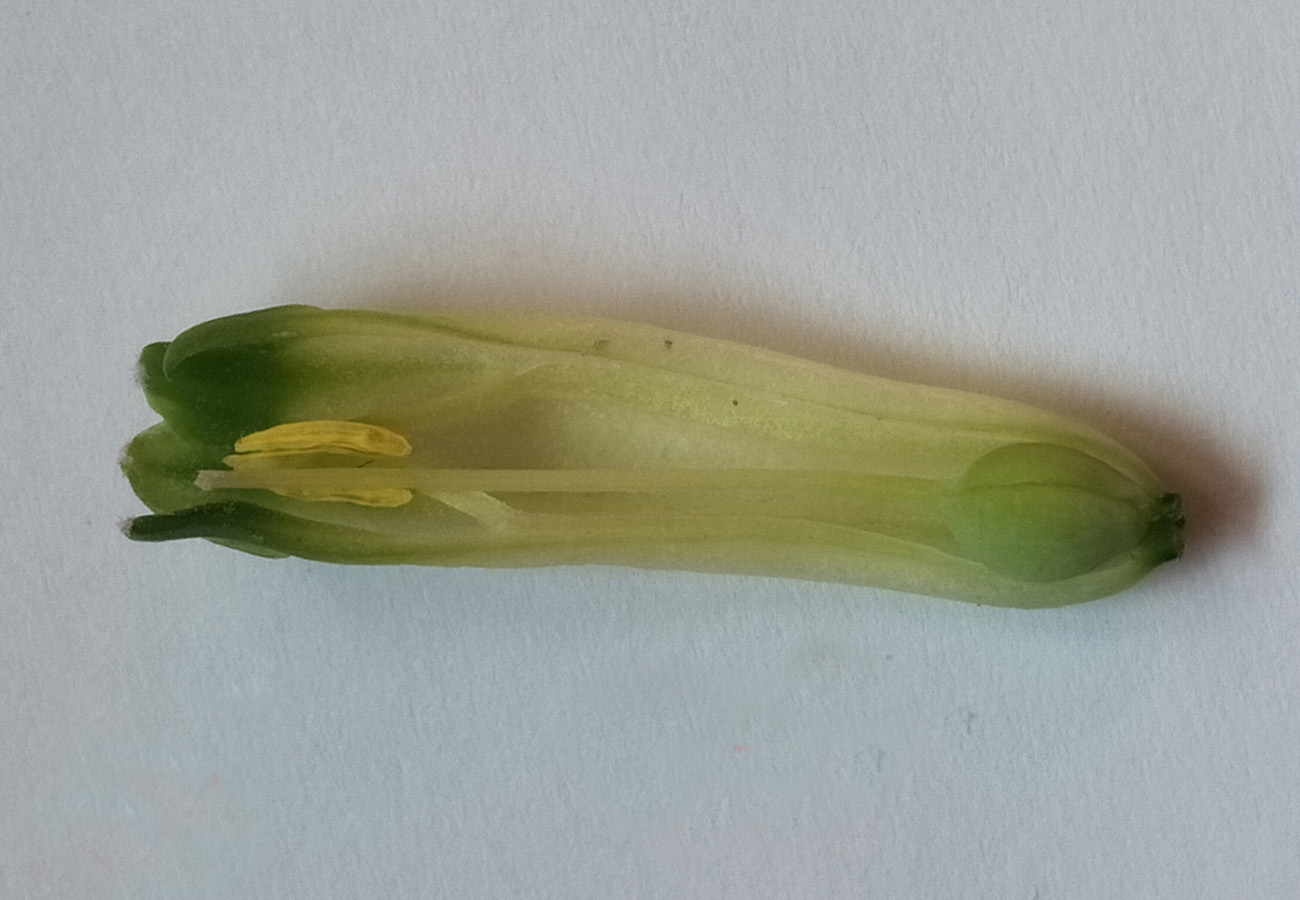Abstract
A new species of Polygonatum (Asparagaceae), Polygonatum caulialatum S. R. Yi from Bashan canyon of Xuanhan, Dazhou, Sichuan, China, is described in this paper, it is similar to P. cyrtonema Hua and P. odoratum (Miller) Druce in appearance for stem glabrous, leaves alternate, corolla campanulate, stamens not exposed, ovary glabrous and berries black, but differs from the former in middle and upper stem slightly flat with two distinct narrow wings, inflorescences 1–2(–3)-flowered, longer perianth lobes, filaments cylindrical and apically not inflated, longer styles and more seeds per berry; and differs from the latter in thicker moniliform rhizome, middle and upper stem slightly flat with two distinct narrow wings, longer perianth lobes, filaments cylindrical, longer anthers and styles, more seeds per berry.
References
APG (2016) An update of the angiosperm phylogeny group classification for the orders and families of flowering plants: APG IV. Botanical Journal of the Linnean Society 181 (1): 1–20. https://doi.org/10.1111/boj.12385
Cai, X.Z., Hu, G.W., Mwihakik, K.E., Mutele, N.V. & Neng, W. (2015) Polygonatum campanulatum (Asparagaceae), a new species from Yunnan, China. Phytotaxa 236 (1): 94–96. https://doi.org/10.11646/phytotaxa.236.1.10
Chao, C.T., Tseng, Y.H. & Tzeng, H.Y. (2013) Heteropolygonatum altelobatum (Asparagaceae), comb. nova. Annales Botanici Fennici 50: 91–94. https://doi.org/10.5735/085.050.0117
Chase, M.W., De Bruijn, A.Y., Cox, A.V., Reeves, G., Rudall, P.J., Johnson, M.A.T. & Eguiarte, L.E. (2000) Phylogenetics of Asphodelaceae (Asparagales): an analysis of plastid rbcL and trnL-F DNA sequences. Annals of Botany 86: 935–951. https://doi.org/10.1006/anbo.2000.1262
Chen, S.C. & Tamura, M.N. (2000) Heteropolygonatum M.N.Tamura & Ogisu. In: Wu, Z.Y. & Raven, P.H. (Eds.) Flora of China, vol. 24. Science Press, Beijing & Missouri Botanical Garden Press, St. Louis, pp. 225–235.
Flora of North America Editorial Committee (2002) Polygonatum. In: Kiger, E. (Ed.) Flora of North America, Vol. 26. Oxford Univ. Press, pp. 210–211.
Floden, A.J. (2014) A New Combination in Polygonatum (Asparagaceae) and the reinstatement of P. mengtzense. Annales Zoologici Fennici 51: 106–116. https://doi.org/10.5735/085.051.0115
Floden, A.J. (2014) New names in Heteropolygonatum (Asparagaceae). Phytotaxa 188 (4): 218–226. https://doi.org/10.11646/phytotaxa.188.4.4
Hance, H.F. (1883) Disporopsis, Genus novum Liliacearum. Journal of Botany, British and Foreign 21: 278.
Hayata, B. (1915) Disporopsis Hance. Icones Plantarum Formos Narum V. ToPPan Press, Tokyo, pp. 230–233.
Jang, C.G. & Pfosser, M. (2002) Phylogenetics of Ruscaceae sensu lato based on plastid rbcL and trnL-F DNA sequences. Stapfia 80: 333–348.
Jin, X.F., Qiu, Y.X. & Ding, B.Y. (2002) Polygonatum cyrtonema var. gutianshanicum—A new variety of Polygonatum cyrtonema and comparative studies on it and the similar species. Journal of Zhejiang University (Agric. & Life Sci.) 28 (5): 537–541.
Judd, W.S. (2003) The genera of Ruscaceae in the southeastern United States. Harvard Papers in Botany 7: 93–149.
Liu, H.H., Ma, Y.S., Wang, B.Z. et al. (2021) Morphologicaland Molecular Characterson a new species of Polygonatum from Hunan, China. Crop research 35 (1): 88–94.
Meng, Y., Nie, Z.L., Deng, T., Wen, J. & Yang, Y.-P. (2014) Phylogenetics and evolution of phyllotaxy in the Solomon’s seal genus Polygonatum (Asparagaceae: Polygonateae). Botanical Journal of the Linnean Society 176: 435–451. https://doi.org/10.1111/boj.12218
Miller, P. (1754) The Gardeners Dictionary. Abridged Vol. ? ed. 4. C Rivington, London, 559 pp.
Tamura, M.N., Chen, S.C. & Turland, N.J. (2000) A New Combination in Heteropolygonatum (Convallariaceae, Polygonateae). Novon 10 (2): 156–157. https://doi.org/10.2307/3393018
Tamura, M.N. & Ogisu, M. (2017) A New Species of the Genus Disporopsis (Convallariaceae) from Sichuan, China. Acta Phytotaxonomica et Geobotanica 49 (1): 143–146.
Tamura, M.N., Ogisu, M. & Xu, J.M. (1997) Heteropolygonatum, a new genus of the tribe Polygonateae (Convallariaceae) from West China. Kew Bull 52: 949–956. https://doi.org/10.2307/4117821
Tamura, M.N., Shizuka, F., Li, H., Yang, Y.-P., Meng, Y. & Ikeda, H. (2014) Polygonatum dolichocarpum (Asparagaceae), a New Species from Yunnan, China. Acta Phytotaxonomica et Geobotanica 65 (3): 157–159.
Tang Y.C. (1978) Polygonatum Mill. In: Wang, F.T. & Tang, T. (Eds.) Flora Reipublicae Popularis Sinicae 15 (2). Science Press, Beijing, pp. 52–81.
Utech, F.H. (2002) Polygonatum. In: Flora of North America Editorial Committee (Org.) Flora of North America, vol. 26. Oxford University Press, Oxford, pp. 210–212.
Wu, Z.L. & Yang, Y.C. (2005) A New Species of Polygonatum Mill. from Qinghai, China. Acta Botanica Boreali-Occidentalia Sinica 25 (10): 2088–2089.
Xu, J.M. (1991) Flora Sichuanica (Tomus 7). Sichuan Nationallity Press, Chengdu, pp. 221–251.
Yamashita, J. & Tamura, M.N. (2000) Molecular phylogeny of the Convallariaceae (Asparagales). In: Wilson, K.L. & Morrison, D.A. (Eds.) Monocots: systematics and evolution. CSIRO Publishing, Melbourne, pp. 387–400.
Yang, H.J., Wu, B.H., Chen, Z.L., Wang, P., Shi, S., Li, F.F., Xu, H. & Cui, D.F. (2020) Polygonatum daminense (Asparagaceae), a new species from China based on morphological and molecular evidence. Phytotaxa 449 (3): 287–294. https://doi.org/10.11646/phytotaxa.449.3.7
Zhao, L.H. & He, X.J. (2014) Polygonatum gongshanense (Asparagaceae), a new species from Gongshan, Yunnan, China. Annales Botanici Fennici 51 (5): 333–336. https://doi.org/10.5735/085.051.0511
Zhao, L.H., Zhou, S.D. & He, X.J. (2018) A phylogenetic study of chinese polygonatum (polygonateae, asparagaceae). Nordic Journal of Botany 37 (2): 1–10. https://doi.org/10.1111/njb.02019


